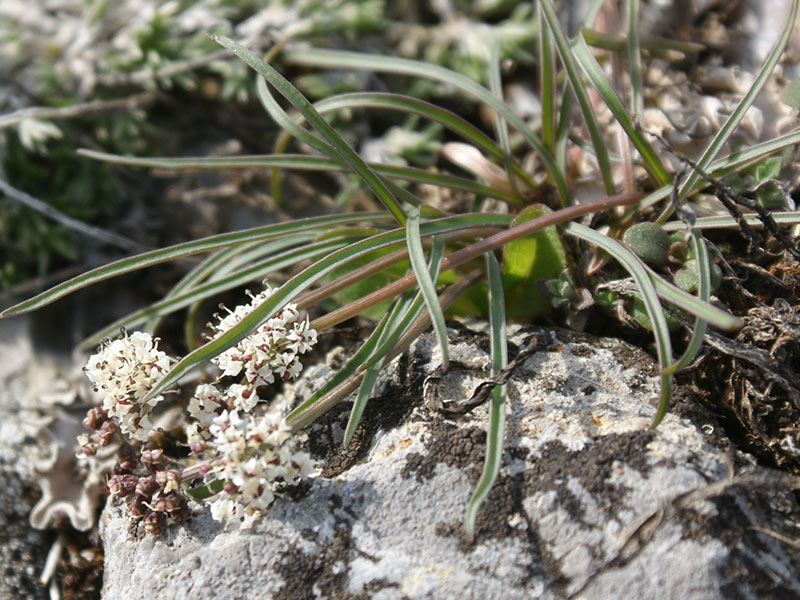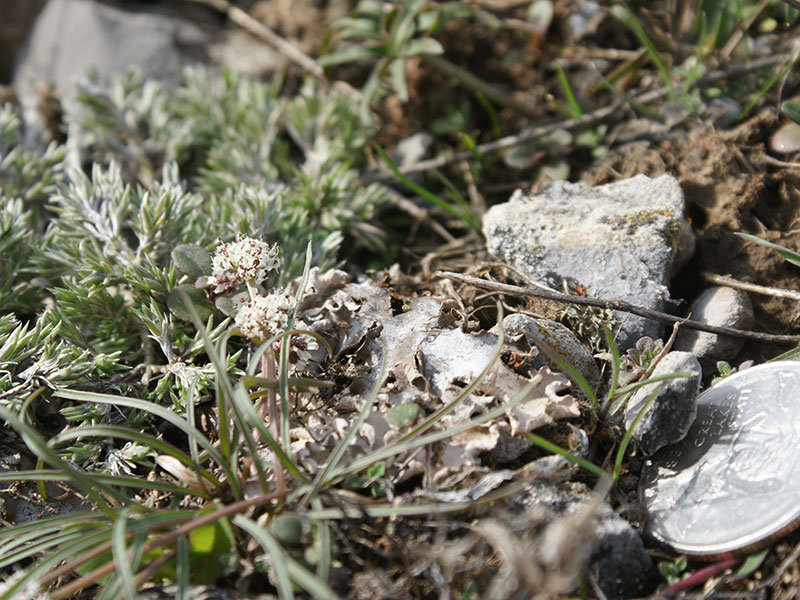Orogenia linearifolia / Indian potato
- spring ephemeral, found only at snowmelt
- very small plant, teeny flowers and teeny umbels
- white flowers with purple dots (stamens)
- grass-like leaves
Also known as: Great Basin Indian potato, Great Basin orogenia, turkey-peas, pepper-and-salt, Indian parsnip
This is a small plant; nay, a teeny plant. It blooms in very early spring, while the snow is melting. Where it blooms is a matter of question. Earl and Lundin (see Resources) say it is limited to moist or soggy places. Others say it is in gravelly areas; still others in sagebrush steppes. One of the problems here is that it blooms well before most groups are out for their spring flower surveys, so it is overlooked. Another is that on rocks, it is nearly impossible to see; I found it on rocks in a sagebrush grove when I was looking at something else next to it. And I found it in a vole field in the central Valley (along with spring beauties) when I was walking a dog and trying to keep him from eating voles. And I found it in roadside ditches on the west side of ID33. Each time, I was looking at something else first, until I had a real search image in my mind, then I found it even more. In some places, it forms extensive colonies and blooms when little else but sagebrush buttercup is around, but I haven’t seen such profusion yet.
Orogenia linearifolia is a spring ephemeral, a rather usual life style for very small plants. This means that it grows quickly as soon as the environment is favorable, blossoms and sets seeds quickly, and then dies back to the point of being undetectable. At Cedron cemetery, I found it first on April 10th; by the 20th, it was gone. It thus avoids the problem of being overtopped by pretty much anything else that can grow nearby. Because of their size, you will pretty much have to lie down to see them. And if you really want to see how cute they are, you may need (gasp) a hand lens (magnifying glass).
The flowers themselves are grouped in compact umbels, typically with 3 or 4, but perhaps 12 rays. Each cluster is flat-topped or nearly so. The smaller, secondary umbels are only about 1/4-inch across but each contains a dozen or more small white flowers. Each flower has 5 nearly invisibly minute petals with 5 purple stamens (visible only because of their color). A single style extends well beyond the rest of the flower. The individual flowers mature at different rates so both new flowers and forming seeds can be in the same umbel.
The plant itself is essentially stemless with the long thin, grass-like leaves arising from the base. If you were to pull an individual leaf off, you would find it is probably cut into three long thin “lobes” that give it a look somewhat like a Turkey’s foot. On some plants, the 3 lobes are actually quite visible (see the Gallery photos).
The common names, “Indian potato” and “turkey peas” refer to peas-size corms from which the leaves grow. These are edible, cooked or raw. Usually, they are round (globose) but may be elongated or tubular. Earle and Lundin (see “Resources“) say that the edibility of these corms is unusual in that they actually taste “good”, rather than being edible “if you really needed to.” They are also popular with bears, sandhill cranes and other critters.
There are only two species in the genus Orogenia. The other one, O. fusiformis, is believed to be rare in Idaho, and can really only be distinguished by the size and shape of the corms.
| Color | |
|---|---|
| Family | |
| Blossom size | |
| Inflorescence size | |
| Inflorescence type | |
| When? | |
| Where? |



